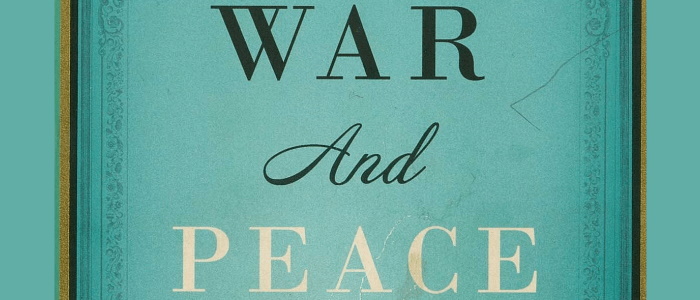Leon Tolstoi: War and Peace
Tolstoi’s War and Peace is, quite simply, the Greatest Novel Ever Written. It is the ultimate historical novel, weaving together the lives, loves and losses of young Russian aristocrats as their society confronted the fearsome might of Napoleon’s Empire, while at the same time embedding within the story Tolstoy’s own philosophies of history and Russian identity. It is also a novel very much of its age – the 1860s in imperial Russia, when it was undergoing an epoch of change. As a story set during the carnage of the Napoleonic Wars, it is deeply researched: Tolstoi read what was the most up-to-date historical literature of the day and visited many of the locations – particularly the site of the charnel house that was Borodino. His descriptions of combat are truly grisly – and, a doctor, he had recently witnessed first-hand the horrible effects that modern warfare has on the human body and spirit, when he was in the siege of Sebastopol during the Crimean War. His quiet pacifism sometimes emerges: the rain falling on the ghastly slopes and ravines, the killing-grounds of Borodino, seems to be saying ‘people, stop, what are you doing?’ Yet the detail also sparkles in the scenes at Saint Petersburg, Moscow and on the country estates: the party at Natasha Rostov’s coming of age (if I recall correctly!) is glittering, the breakneck horse-riding on a hunt, the eccentricities of Andrei Bolkonskii’s father, and so on…But what also makes this novel are the characters: they, including (and perhaps especially) the women, are finely-drawn – the nobility, courage and self-control of Andrei, Pierre Bezukhov’s indecisiveness, his reflectiveness, his search for meaning, purpose and to do good, Anatole Kuragin’s selfishness, and Natasha’s strength, compassion, and impulsiveness. I think that these are human features that we all share, to a greater and lesser degree. But it is Natasha who really makes the novel.
This is a story centred on the aristocracy: the people are large crowds adoring the Tsar or the serried, green ranks of the Russian soldiery or – and here’s the rub – individuals with an innate wisdom: Platon Karatayev, imprisoned by Napoleon and eventually shot, shares his natural worldview of fatalistic piety and kindness with Pierre, who is also held by the French but who survives to be rescued by the Cossacks. And this is why the novel works at another level, beyond its compelling narratives and strong characterisations. It reflects Tolstoy’s sense of Russianness, an identity that rises from the mass of people, who have a thing or two to teach the aristos. Natasha, famously, feels this strong sense of the people surge inside her as she dances with some peasants in one of the novel’s most iconic moments. It also expresses Tolstoi’s idea of the past, in some ways anticipating the social historians of the 20th century by emphasising that history is made not by ‘Great Men’ but by the choices, decisions and determination of the great mass of the people – the ‘oceanic surge of the peoples’, he calls it at one point. He expounds on this in some depth in the epilogue. War and Peace also works as a historical document in itself, rooted in the context in which it was written, as Russia – and Tolstoy himself, as an estate-owner at Yasnaya Polyana – grappled with Tsar Alexander II’s Great Reforms, including the abolition of serfdom, that began in the 1860s. Not only that, it also flowed from the pen of an author who was no stranger to tussles with the Tsarist state, an experience shared – often in far worse ways – by other members of the Russian intelligentsia. This ‘parting of ways’ between the state and the more progressive elements in the nobility is one of the subterranean currents in the story – and it ends, some years after the Napoleonic Wars, with the hushed discussions of liberal nobles who would eventually try to topple the Tsar in what would be remembered as the Decembrist uprising in 1825. And when we first meet the young Pierre at the beginning, he blurts out in company that ‘the French Revolution was a splendid thing’ (I like that line…).
I first encountered War and Peace as a child: it was on my parent’s bookshelves in the living room when I was small. As I grew older, as my fascination with the past grew and as I learned more and more about my Russian heritage, the book seemed to present a challenge. But I didn’t get around to reading it until I was doing my doctoral research in Paris. At lunchtimes I’d sometimes take my packed lunch (or when feeling more flush, buy a baguette sandwich from a boulangerie, when less so a plain half baguette, which in those days could be had for 50 centimes), and sit somewhere near the archives and read Tolstoi’s great novel. I remember one particularly happy occasion sitting on a bench near the Hôtel de Sens on a cold, crisp January day and being so absorbed in the story that time trickled by until I realised that the archives were about to close and, with some reluctance, had to close the book, which always sat with a reassuring heft in my knapsack, and jog back to where I had left my work. It took me two years to read – not because, as I had expected, it was a challenge, but because it was an almost sensuous pleasure – absorbing Tolstoi’s eye for fine detail, for human foibles and for landscape. When picking up where I left off, I’d often backtrack a chapter to revisit what I had enjoyed previously and let the momentum of the tale sweep me along. War and Peace is the ultimate historian’s novel. Read it and savour it…I now have to read it again…


